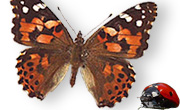 The scorpion's body is divided into two main segments: the cephalothorax (also called the prosoma) and the abdomen/opisthosoma. The abdomen consists of the mesosoma and the metasoma.
Cephalothorax/prosoma: the scorpion's “head”, comprising the carapace, eyes, chelicerae (mouth parts), pedipalps (claw) and the four pairs of walking legs.
Mesosoma: the abdomen's first half, is made up of six segments. The first segment contains the sexual organs as well as a pair of vestigial and modified appendages forming a structure called the genital operculum. The second segment bears a pair of featherlike sensory organs known as the pectines; the final four segments each contain a pair of book lungs. The mesosoma is armoured with chitinous plates, the tergites plates upper surface and the sternites plates the lower surface.
Metasoma: the scopion's tail, comprising six segments (the first tail segment looks like a last mesosoman segment), the last containing the scopion's anus and bearing the telson (the sting). The telson, in turn, consists of the vesicle, which holds a pair of venom (poison) glands and the hypodermic aculeus, the vemon injecting barbex.
Cuticle: this makes a tough armour around the body. In some places it is covered with hairs that act like balance organs. An outer layer that makes them fluoresce green under ultraviolet light is called the hyaline layer. Newly molted scorpions do not glow until after their cuticle has hardened. The fluoresent hyaline layer can be intact in hundreds of millions of year-old fossil rocks. |





